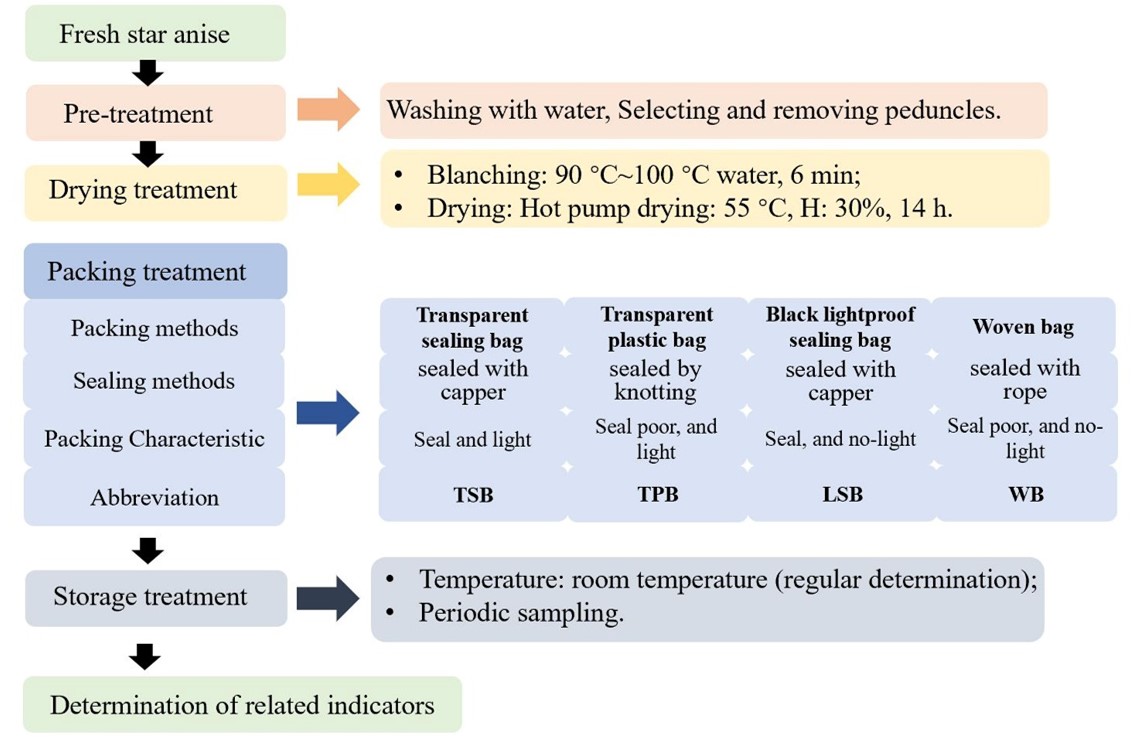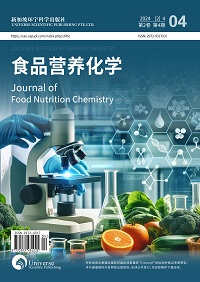包装方式对室温储存下干制八角(Illicium verum Hook.f.)颜色、挥发油、莽草酸和挥发性物质的影响
DOI:
https://doi.org/10.18686/zhfnc.v1i3.94关键词:
八角;包装方法;贮藏;理化性质;挥发性成分摘要
消费者对食品包装和食品质量的要求越来越高,因此在贮藏过程中保持其品质就显得尤为重要,特别是是香辛料。本研究采用四种不同的包装方法(透明密封袋(transparent sealing bag,TSB)、透明塑料袋(transparent plastic bag,TPB)、黑色避光密封袋(lightproof sealing bag,LSB)和编织袋(woven bag,WB))对干制八角进行包装处理,并在室温下贮藏一年。在贮藏过程中监测了水分含量、挥发油(volatile oil,VO)及其主要物质(反式-茴香脑)(trans-anethole,TA-O)、莽草酸(shikimic acid,SA)、主要挥发性物质和真菌毒素的变化。结果表明,两种密封包装方法(TSB和LSB)的防吸潮效果优于非密封包装方法(WB和TPB)。此外,采用TSB包装的八角色泽最好,但LSB包装能有效减少SA、VO和TA-O的损失。通过气相色谱-质谱联用仪(gas chromatography-mass spectrometer,GC-MS)和主成分分析(principal component analysis,PCA)得出,LSB样品的挥发性物质得分最高,其次是TSB、TPB和WB。最后,使用层次聚类分析(hierarchical clustering analysis,HCA)评估了干制八角在保存过程中使用不同包装方法的质量特性。综合以上结果,LSB是干制八角在室温下的最佳贮藏方法。

##submission.downloads##
已出版
文章引用
期
栏目
执照
版权声明
CC BY-NC 4.0作者应保留其作品的版权,并授予期刊/出版商首次出版该作品的权利,同时根据以下条款获得许可: 知识共享署名-非商业性4.0国际版(CC BY-NC 4.0)。本许可证允许复制、分发和传播作品,前提是声明了原创作者的正确归属。
参考
1. Saunders RMK. Systematics of the genus Illicium L.(Illiciaceae) in Malesia. Botanical Journal of the Linnean Society 1995; 117(4): 333–352. doi: 10.1111/j.1095-8339.1995.tb02588.x
2. Chouksey D, Upmanyu N, Pawar RS. Central nervous system activity of Illicium verum fruit extracts. Asian Pacific Journal of Tropical Medicine 2013; 6(11): 869–875. doi: 10.1016/S1995-7645(13)60155-8
3. Sabry BA, Farouk A, Badr AN. Bioactivity evaluation for volatiles and water extract of commercialized star anise. Heliyon 2021; 7(8): e07721. doi: 10.1016/j.heliyon.2021.e07721
4. Cai M, Luo Y, Chen J, et al. Optimization and comparison of ultrasound-assisted extraction and microwave-assisted extraction of shikimic acid from Chinese star anise. Separation and Purification Technology 2014; 133: 375–379. doi: 10.1016/j.seppur.2014.06.064
5. Wang GW, Hu WT, Huang BK, Qin LP. Illicium verum: A review on its botany, traditional use, chemistry and pharmacology. Journal of Ethnopharmacology 2011; 136(1): 10–20. doi: 10.1016/j.jep.2011.04.051
6. Kanatt SR, Chawla SP, Sharma A. Antioxidant and radio-protective activities of lemon grass and star anise extracts. Food Bioscience 2014; 6: 24–30. doi: 10.1016/j.fbio.2014.03.002
7. Padmashree A, Roopa N, Semwal AD, et al. Star-anise (Illicium verum) and black caraway (Carum nigrum) as natural antioxidants. Food Chemistry 2007; 104(1): 59–66. doi: 10.1016/j.foodchem.2006.10.074
8. Wang L, Liang Y, Wang Z, et al. Ultrasonic nebulization extraction coupled with on-line gas chromatography for determination of trans-anethole in spices. Talanta 2009; 80(2): 864–869. doi: 10.1016/j.talanta.2009.08.006
9. Ohira H, Torii N, Aida TM, et al. Rapid separation of shikimic acid from Chinese star anise (Illicium verum Hook. f.) with hot water extraction. Separation and Purification Technology 2009; 69(1): 102–108. doi: 10.1016/j.seppur.2009.07.005
10. Dongare V, Kulkarni C, Kondawar M, et al. Inhibition of aldose reductase and anti-cataract action of trans-anethole isolated from Foeniculum vulgare Mill. fruits. Food Chemistry 2012; 132(1): 385–390. doi: 10.1016/j.foodchem.2011.11.005
11. Samadi-Noshahr Z, Ebrahimzadeh-Bideskan A, Hadjzadeh MAR, et al. trans-Anethole attenuated renal injury and reduced expressions of angiotensin II receptor (AT1R) and TGF-β in streptozotocin-induced diabetic rats. Biochimie 2021; 185: 117–127. doi: 10.1016/j.biochi.2021.03.011
12. Giuffrida D, Dugo P, Torre G, et al. Evaluation of carotenoid and capsaicinoid contents in powder of red chili peppers during one year of storage. Food Research International 2014; 65: 163–170. doi: 10.1016/j.foodres.2014.06.019
13. Karam L, Salloum T, El Hage R, et al. How can packaging, source and food safety management system affect the microbiological quality of spices and dried herbs? The case of a developing country. International Journal of Food Microbiology 2021; 353: 109295. doi: 10.1016/j.ijfoodmicro.2021.109295
14. Korkmaz A, Atasoy AF, Hayaloglu AA. Changes in volatile compounds, sugars and organic acids of different spices of peppers (Capsicum annuum L.) during storage. Food Chemistry 2020; 311: 125910. doi: 10.1016/j.foodchem.2019.125910
15. Misra N. Influence of temperature and relative humidity on fungal flora of some spices in storage. Zeitschrift für Lebensmittel-Untersuchung und-Forschung 1981; 172(1): 30–31. doi: 10.1007/BF01255458
16. Mizani M, Sheikh N, Ebrahimi SN, et al. Effect of gamma irradiation on physico-mechanical properties of spice packaging films. Radiation Physics and Chemistry 2009; 78(9): 806–809. doi: 10.1016/j.radphyschem.2009.04.021
17. Codex Alimentarius International Food Standards. Code of practice for the prevention and reduction of mycotoxins in spices: CAC/RCP 78-2017. Available online: https://www.fao.org/fao-who-codexalimentarius/sh-proxy/es/?lnk=1&url=https%253A%252F%252Fworkspace.fao.org%252Fsites%252Fcodex%252FStandards%252FCXC%2B78-2017%252FCXC_078e.pdf (accessed on 21 November 2023).
18. Cheng J, Ke J, Hou X, et al. Changes in qualities of dried Zanthoxylum armatum DC. at different storage methods. Food Packaging and Shelf Life 2021; 29: 100716. doi: 10.1016/j.fpsl.2021.100716
19. Yang R. The Study on the Stability of Numb-Taste Of Zanthoxylum and its Product in Different Treatments and Storage Conditions [PhD thesis]. Heibei University of Engineering; 2018.
20. Duman AD. Storage of red chili pepper under hermetically sealed or vacuum conditions for preservation of its quality and prevention of mycotoxin occurrence. Journal of Stored Products Research 2010; 46(3): 155–160. doi: 10.1016/j.jspr.2010.02.002
21. Ding Z, Wang Z, Zheng W, et al. Principal component analysis of volatile flavor compounds of dried peppers with different packaging (Chinese). Journal of Chinese Institute of Food Science and Technology 2014; 14(1): 285–292. doi: 10.16429/j.1009-7848.2014.01.038.
22. Shi Y, Chen G, Chen K, et al. Assessment of fresh star anise (Illicium verum Hook.f.) drying methods for influencing drying characteristics, color, flavor, volatile oil and shikimic acid. Food Chemistry 2021; 342: 128359. doi: 10.1016/j.foodchem.2020.128359
23. Liu S, Wang H, Ma S, et al. Radiofrequency-assisted hot-air drying of Sichuan pepper (Huajiao). LWT—Food Science and Technology 2021; 135: 110158. doi: 10.1016/j.lwt.2020.110158
24. Wu X, Zhang M, Li Z. Influence of infrared drying on the drying kinetics, bioactive compounds and flavor of Cordyceps militaris. LWT—Food Science and Technology 2019; 111: 790–798. doi: 10.1016/j.lwt.2019.05.108
25. Zhang L. Research on the Extraction Process of Shikimicacid from the Pericarps of Illicium Macranthum A.C. Smith [Master’s thesis]. Jianghan University; 2017.
26. Jia C, Zhang X, Sun X, et al. Determination of volatile components from Illicium verum Hook. F. by HS-SPME and GC-MS (Chinese). Journal of Zhengzhou University of Light Industry (Natural Science Edition) 2009; 24(2): 21–26.
27. Gholivand MB, Rahimi-Nasrabadi M, Chalabi H. Determination of essential oil components of star anise (Illicium verum) using simultaneous hydrodistillation–static headspace liquid-phase microextraction–gas chromatography mass spectrometry. Analytical Letters 2009; 42(10): 1382–1397. doi: 10.1080/00032710902961081
28. Kulapichitr F, Borompichaichartkul C, Suppavorasatit I, Cadwallader KR. Impact of drying process on chemical composition and key aroma components of Arabica coffee. Food Chemistry 2019; 291: 49–58. doi: 10.1016/j.foodchem.2019.03.152
29. Zhao D, Tang J, Ding X. Analysis of volatile components during potherb mustard (Brassica juncea, Coss.) pickle fermentation using SPME–GC-MS. LWT—Food Science and Technology 2007; 40(3): 439–447. doi: 10.1016/j.lwt.2005.12.002
30. Wu X, Zhang X, Yang Y, et al. Development of a deep eutectic solvent-based matrix solid phase dispersion methodology for the determination of aflatoxins in crops. Food Chemistry 2019; 291: 239–244. doi: 10.1016/j.foodchem.2019.04.030
31. Giancarlo B, Elisabetta B, Edmondo C, et al. Determination of ochratoxin A in eggs and target tissues of experimentally drugged hens using HPLC–FLD. Food Chemistry 2011; 126(3): 1278–1282. doi: 10.1016/j.foodchem.2010.11.070
32. Wang Q, Ou Z, Jiang L, Wen Q. Influences of different drying methods and cultivation areas on the quality of star anise fruit. China Condiment 2010; 9: 48–55. doi: 10.3969/j.issn.1000-9973.2010.09.007
33. Udomkun P, Nagle M, Argyropoulos D, et al. Compositional and functional dynamics of dried papaya as affected by storage time and packaging material. Food Chemistry 2016; 196: 712–719. doi: 10.1016/j.foodchem.2015.09.103
34. Yu C, Zhang J, Wang T. Star anise essential oil: Chemical compounds, antifungal and antioxidant activities: A review. Journal of Essential Oil Research 2021; 33(1): 1–22. doi: 10.1080/10412905.2020.1813213
35. Li P, Shu Z, Shen X, et al. Effects of storage time and methods on weight loss and antimicrobial activity of star anise oil (Chinese). Food and Fermentation Industry 2017; 43(2): 232–238. doi: 10.13995/j.cnki.11-1802/ts.201702040.
36. Liang Y. Study on Quality Change and Influencing Factors of Chuanxiong Rhizoma During Storage [Master’s thesis]. Chengdu University of Traditional Chinese Medicine; 2018.
37. Singh G, Maurya S, deLampasona MP, Catalan C. Chemical constituents, antimicrobial investigations and antioxidative potential of volatile oil and acetone extract of star anise fruits. Journal of the Science of Food and Agriculture 2005; 86(1): 111–121. doi: 10.1002/jsfa.2277
38. Ghosh S, Chisti Y, Banerjee UC. Production of shikimic acid. Biotechnology Advances 2012; 30(6): 1425–1431. doi: 10.1016/j.biotechadv.2012.03.001
39. Hasegawa T, Seimiya H, Fujihara T, et al. Aroma profile of star anise and the structure-odor relationship of anethole. Natural Product Communications 2014; 9(2): 251–256. doi: 10.1177/1934578X1400900230
40. Yildiz S, Pokhrel PR, Unluturk S, Barbosa-Cánovas GV. Shelf life extension of strawberry juice by equivalent ultrasound, high pressure, and pulsed electric fields processes. Food Research International 2021; 140: 110040. doi: 10.1016/j.foodres.2020.110040


